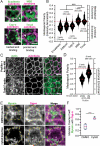Apical Sarcomere-like Actomyosin Contracts Nonmuscle Drosophila Epithelial Cells
- PMID: 27773487
- PMCID: PMC5102765
- DOI: 10.1016/j.devcel.2016.09.023
Apical Sarcomere-like Actomyosin Contracts Nonmuscle Drosophila Epithelial Cells
Abstract
Actomyosin networks generate contractile force that changes cell and tissue shape. In muscle cells, actin filaments and myosin II appear in a polarized structure called a sarcomere, in which myosin II is localized in the center. Nonmuscle cortical actomyosin networks are thought to contract when nonmuscle myosin II (myosin) is activated throughout a mixed-polarity actin network. Here, we identified a mutant version of the myosin-activating kinase, ROCK, that localizes diffusely, rather than centrally, in epithelial cell apices. Surprisingly, this mutant inhibits constriction, suggesting that centrally localized apical ROCK/myosin activity promotes contraction. We determined actin cytoskeletal polarity by developing a barbed end incorporation assay for Drosophila embryos, which revealed barbed end enrichment at junctions. Our results demonstrate that epithelial cells contract with a spatially organized apical actomyosin cortex, involving a polarized actin cytoskeleton and centrally positioned myosin, with cell-scale order that resembles a muscle sarcomere.
Keywords: ROCK; actin cortex; cell polarity; contraction; epithelia; morphogenesis; myosin; sarcomere.
Copyright © 2016 Elsevier Inc. All rights reserved.
Figures







Comment in
-
A Radial Actin Network in Apical Constriction.Dev Cell. 2016 Nov 7;39(3):280-282. doi: 10.1016/j.devcel.2016.10.017. Dev Cell. 2016. PMID: 27825436
Similar articles
-
Rho GTPase and Shroom direct planar polarized actomyosin contractility during convergent extension.J Cell Biol. 2014 Feb 17;204(4):575-89. doi: 10.1083/jcb.201307070. J Cell Biol. 2014. PMID: 24535826 Free PMC article.
-
Architecture of the cortical actomyosin network driving apical constriction in C. elegans.J Cell Biol. 2023 Sep 4;222(9):e202302102. doi: 10.1083/jcb.202302102. Epub 2023 Jun 23. J Cell Biol. 2023. PMID: 37351566 Free PMC article.
-
A self-organized biomechanical network drives shape changes during tissue morphogenesis.Nature. 2015 Aug 20;524(7565):351-5. doi: 10.1038/nature14603. Epub 2015 Jul 27. Nature. 2015. PMID: 26214737
-
Contractile and expansive actin networks in Drosophila: Developmental cell biology controlled by network polarization and higher-order interactions.Curr Top Dev Biol. 2023;154:99-129. doi: 10.1016/bs.ctdb.2023.02.005. Epub 2023 Mar 14. Curr Top Dev Biol. 2023. PMID: 37100525 Review.
-
Unique and redundant functions of cytoplasmic actins and nonmuscle myosin II isoforms at epithelial junctions.Ann N Y Acad Sci. 2022 Sep;1515(1):61-74. doi: 10.1111/nyas.14808. Epub 2022 Jun 7. Ann N Y Acad Sci. 2022. PMID: 35673768 Free PMC article. Review.
Cited by
-
Self-organized cytoskeletal alignment during Drosophila mesoderm invagination.Philos Trans R Soc Lond B Biol Sci. 2020 Oct 12;375(1809):20190551. doi: 10.1098/rstb.2019.0551. Epub 2020 Aug 24. Philos Trans R Soc Lond B Biol Sci. 2020. PMID: 32829683 Free PMC article.
-
Dia- and Rok-dependent enrichment of capping proteins in a cortical region.J Cell Sci. 2021 Nov 1;134(21):jcs258973. doi: 10.1242/jcs.258973. Epub 2021 Nov 5. J Cell Sci. 2021. PMID: 34633047 Free PMC article.
-
Extent of myosin penetration within the actin cortex regulates cell surface mechanics.Nat Commun. 2021 Nov 11;12(1):6511. doi: 10.1038/s41467-021-26611-2. Nat Commun. 2021. PMID: 34764258 Free PMC article.
-
Orchestrating morphogenesis: building the body plan by cell shape changes and movements.Development. 2020 Sep 11;147(17):dev191049. doi: 10.1242/dev.191049. Development. 2020. PMID: 32917667 Free PMC article. Review.
-
Combinatorial patterns of graded RhoA activation and uniform F-actin depletion promote tissue curvature.Development. 2021 Jun 1;148(11):dev199232. doi: 10.1242/dev.199232. Epub 2021 Jun 14. Development. 2021. PMID: 34124762 Free PMC article.
References
-
- Amano M, Ito M, Kimura K, Fukata Y, Chihara K, Nakano T, Matsuura Y, Kaibuchi K. Phosphorylation and Activation of Myosin by Rho-associated Kinase (Rho-kinase). Journal of Biological Chemistry. 1996;271:20246–20249. - PubMed
-
- Backouche F, Haviv L, Groswasser D, Bernheim-Groswasser A. Active gels: dynamics of patterning and self-organization. Phys Biol. 2006;3:264–273. - PubMed
-
- Bai J, Hartwig JH, Perrimon N. SALS, a WH2-domain-containing protein, promotes sarcomeric actin filament elongation from pointed ends during Drosophila muscle growth. Developmental Cell. 2007;13:828–842. - PubMed
-
- Barrett K, Leptin M, Settleman J. The Rho GTPase and a Putative RhoGEF Mediate a Signaling Pathway for the Cell Shape Changes in Drosophila Gastrulation. Cell. 1997;91:905–915. - PubMed
Publication types
MeSH terms
Substances
Grants and funding
LinkOut - more resources
Full Text Sources
Other Literature Sources
Molecular Biology Databases

